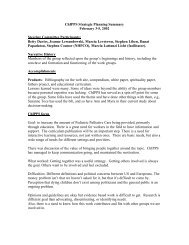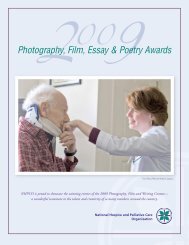PDF version - National Hospice and Palliative Care Organization
PDF version - National Hospice and Palliative Care Organization
PDF version - National Hospice and Palliative Care Organization
You also want an ePaper? Increase the reach of your titles
YUMPU automatically turns print PDFs into web optimized ePapers that Google loves.
Our practice is to follow the<br />
patient’s expressed wishes. If<br />
the patient has been interacting,<br />
but does not answer a particular<br />
question, we interpret this as<br />
“I don’t know,” <strong>and</strong> then stop<br />
the process. If the patient is<br />
unresponsive, we rely on advance<br />
directives. In the absence of<br />
advance directives, we identify<br />
the legal decision-maker<br />
according to our policy.<br />
We conclude the conversation<br />
by explaining what to expect<br />
from us, what might be needed<br />
from them, <strong>and</strong> who will be their<br />
contact persons at our program.<br />
Our admitting nurse then notifies<br />
the receiving team to anticipate<br />
this complex case, <strong>and</strong> arranges<br />
for a social worker <strong>and</strong> chaplain<br />
to meet the patient <strong>and</strong> family to<br />
assess the psycho-social-spiritual<br />
aspects of their lives <strong>and</strong> the<br />
implications for care.<br />
This is the time to clarify who is<br />
considered “family.” Is the patient<br />
legally married to one partner,<br />
but currently living with another<br />
who has assumed that role? Does<br />
the staff at the patient’s long-term<br />
care facility consider themselves<br />
family <strong>and</strong> want to be informed<br />
of the patient’s care at every stage<br />
of decline? If there is complex<br />
care to be rendered, is there<br />
someone who is willing <strong>and</strong> able<br />
to assist in a caregiving capacity?<br />
If so, who will be training them?<br />
What exactly are the orders <strong>and</strong><br />
instructions for that care?<br />
Finally, does your organization’s<br />
policies <strong>and</strong> procedures support<br />
the care that is needed <strong>and</strong><br />
requested? During our review of<br />
the case, a nursing director or<br />
chief clinical officer reviews all<br />
policies that apply to the patient’s<br />
situation. Any questions that<br />
surface from this review must<br />
then be addressed.<br />
In Practice:<br />
The Case of Jimmy<br />
Jimmy was a 32-year-old man<br />
with Down Syndrome, whose<br />
multiple medical conditions had<br />
brought him to a terminal state.<br />
He had been a long-term resident<br />
of a group home that cared for the<br />
developmentally disabled until<br />
his care required admittance to<br />
the area hospital. The group home<br />
<strong>and</strong> hospital were about 150 miles<br />
away from his parents’ home,<br />
which was located in our service<br />
area. Now, given his illness,<br />
his parents wanted to have him<br />
closer to them.<br />
Pages <strong>and</strong> pages of records about<br />
Jimmy arrived at our hospice for<br />
review. The physician <strong>and</strong> staff at<br />
our hospice house reviewed every<br />
page, looking for clues about the<br />
best way to manage his care. We<br />
learned that Jimmy was in fourcontinued<br />
on next page<br />
A nursing director<br />
or chief clinical officer<br />
reviews all policies<br />
that apply to the<br />
patient’s situation.<br />
NewsLine 5









